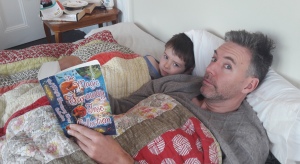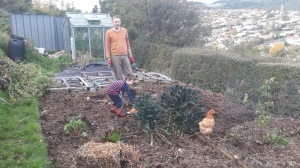Occasional notes on what I’ve read.
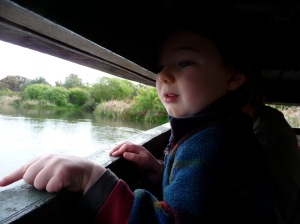 Steve Braunias, How to Watch a Bird
Steve Braunias, How to Watch a Bird
The Cat was a fully-fledged birdo by the time he was one. I don’t know why — I was a brand new and desperately sleep-deprived mother, so who knows what I was thinking, every thought was of shining, crucial importance, shimmering with light and meaning, ungraspable, everything and nothing, over and over and over — but I spent hours sitting on the sofa with him flicking through bird books and telling him the names of the birds. He even had a bird book for meal times, which became so thoroughly encrusted with food that we had to buy a new one. We went on outings to places where we could see birds, we kept lists of birds we had seen, we bought binoculars and guides and found websites and painted pictures and basically it was birds birds birds until he discovered bus routes aged four or so. After that it was maps and bus journeys and bus poems and bus games and visits to the bus station, and then it was briefly dinosaurs and a short stint of car names, and then geography, and now soccer. Each time, his interest has been total, comprehensive, encyclopedic and consuming.
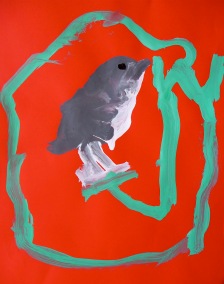
New Zealand robin, toutouwai (18cm): The robin is a small bush bird found in many lovely places, especially Ulva Island. The Cat saw robins at the Karori Sanctuary.
We eased off on the birds for a while, but the interest is still there in the background, as are the birds ever and always.
Somewhere in all that birding time, I read How to Watch a Bird by Steve Braunias. Before that, I’d read his Listener columns on birds and I’d started to notice birds, to see them in all their strangeness and familiarity. Australia helped, with its pelicans and parrots and fairy wrens and crows and magpies. You’d have to be blind and deaf to not notice the birds in Australia; they’re all colour and noise and foreboding and joy, and they’re right there every time you step out the door.
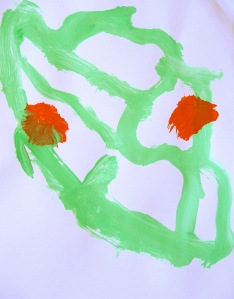
Kea (46cm): The kea is a mountain parrot found mostly in the South Island high country. It is olive-green, with orange-red on its rump and under its wings. The Cat has never seen a kea in the wild, but he spotted them at Staglands and Wellington Zoo. He does a very good impression.
So I had those two birders, Braunias and my boy, reminding me to look, to be still, to wonder, to observe. But I didn’t think to bring them together until I heard Braunias talk at the Dunedin Writers and Readers Festival. He was funny and cogent and even wise, and I realised that I wanted my son to read his book. I wanted the Cat to have stories and people to go along with the facts and numbers and maps and descriptions, and I got them for him, signed and inscribed by the author himself. It’s a lovely book and if you don’t have it on your Sunday afternoon bookshelf already, then your Sunday afternoons are not everything they could be.
The Cat’s verdict: ‘Pretty good, actually.’ The Cat never sugar-coats, so I’m taking that as high praise. Plus he’s quoting from it, which is the better sign really. A sample, to convince you:
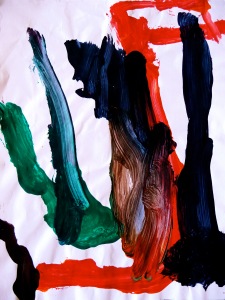
Mandarin duck (51cm): The mandarin duck is a colourful Asian duck, which eats rice. The Cat saw this duck at the Melbourne and Adelaide zoos, and at Staglands.
Keith was very nearly a classic New Zealand birder — long and loping build, wears a beard, but came from Invercargill. He’s an accomplished artist. He lives in a house right next to the centre. It was a rather desolate spot, a sea breeze stirring the flax, and his only neighbours were birds; and yet, like me, he couldn’t drive. He hosts 12,000 visitors a year. There is a lodge at the centre for overnight accommodation — the day I arrived, a merry group of Lionesses were drying dishes and making lewd jokes.
Keith walked me towards the shore. As a bonus, there was a single white heron, white and absolutely enormous, reaching to the sky on its slender black legs. I could add it to my year twitching list of the black stilt, the terek sandpiper, and a very weird sighting of an albino oystercatcher. Feeding on the tide were 300 wrybills, about 500 red knots, and 1500 to 1800 bar-tailed godwits.

Eastern rosella (33cm): Originally from Australia, the rosella is a noisy, social bird with bright plumage. The Cat saw a flock of six rosellas at Orokonui Sanctuary near Dunedin.
The godwits were slim — they lose drastic amounts of body fat on the long voyage to New Zealand — and small, and slow, and dazed, and greedy. Their sensitive bills probed the sand for movement. They feed on crabs by shaking the legs off one by one, and then scoffing the body whole. For dessert, they eat the legs. They had come all this way — light, precious things that witnessed cataclysmal horror, curdling temperatures, terraqueous distortions, all the rest — and I stood and watched them on a white-shelled shore on a cold afternoon. It was Friday, 15 September.
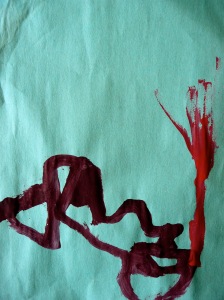
Superb lyrebird (100cm): The lyrebird is a remarkable songbird found in the bush of south-eastern Australia. The Cat saw a superb lyrebird at Adelaide Zoo. In the ‘Life of Birds’ DVD, David Attenborough listens to a lyrebird making the sounds of a chainsaw, a kookaburra, a camera and a car alarm.
Braunias writes about birds and birders, and about himself and New Zealand too. It’s like an avian social history ethnologico-geographico-zoological guidebook memoir, but really more like a rambling walk on the seashore with a kind, wonderful, sharp-tongued friend, and what better for your nine-year-old son as he figures out who he wants to be and what he knows and what he needs to learn.
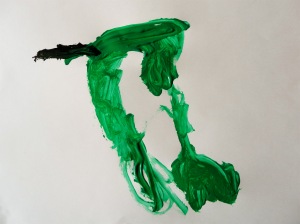
Bellbird, korimako, makomako (20cm): The bellbird is a songbird, endemic to New Zealand. It drinks nectar, and loves sugar water. There are lots of bellbirds at Granny and Dada’s house and at Taieri Mouth. The Cat also heard bellbirds at Karori Wildlife Sanctuary.
After reading the book, we took the Hoopers Inlet road home from a soccer match at Portobello. We dropped over the hill and saw the inlet plunk down in front of us, curved and graceful and quiet and full of birds. Swans, herons, kingfishers, pied stilts, spur-winged plovers, oystercatchers, paradise shelducks, ordinary ducks, pukeko, the lot. The Cat’s antennae lifted, he named each bird he saw, told stories, showed his little brother this feathered, mud-shanked, fish-catching, sand-probing, greens-foraging world. He became a birder again, and his own gentle, clever, funny self. I ruffled his hair, looked at the water, drove home.
* The pictures and captions are from a calendar the Cat made for Christmas 2009, and he would like to point out that he was not yet four at the time.
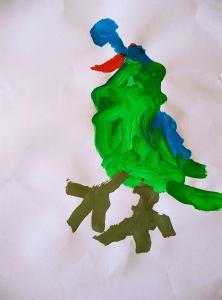
Blue-crowned parakeet, kakariki (32cm): The Cat made this bird up. It is slightly larger than its cousins, the red-crowned, yellow-crowned and Antipodes Island parakeets.
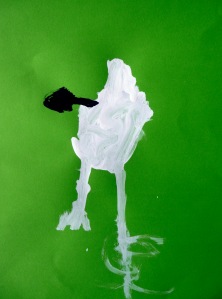
Royal spoonbill (78cm): The spoonbill is a wading bird, which sifts the water for small crustacea. The Cat saw spoonbills at Manawatu estuary and in the crescent lagoons on the road to Port Chalmers. The first spoonbills of the season are rightly greeted with the cry, ‘Welcome back, spoonbills!’
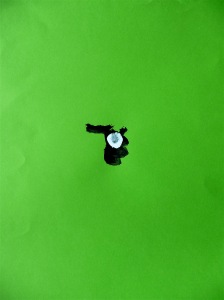
Little shag, kawaupaka (56cm): The little shag is the most common of the fresh-water shags. It feeds on fish, crayfish and eels, diving from the surface of the water. The Cat saw two little shags on wood and water in the Hutt River.
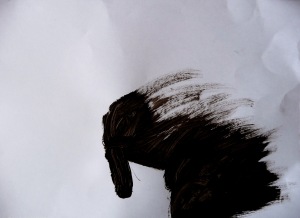
Piwakawaka, fantail (16cm): The fantail is a companionable bush bird, which finds humans useful for stirring up insects. One afternoon, the Cat saw three fantails together at the Nursery.
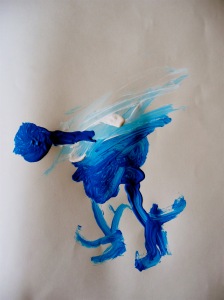
Korora, little blue penguin (40cm): Little and blue is a good way to describe this bird. At Moa Point, signs warn cars to slow down so the korora can cross the road to their burrows. The Cat saw korora swimming at Stewart Island.
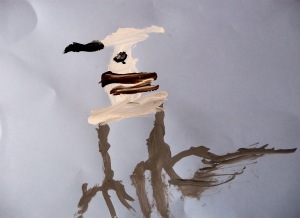
Banded dotterel (20cm): The banded dotterel is an elegant wading bird, which breeds only in New Zealand. In winter, it migrates to the North Island and to Australia. Daddy saw a dotterel at Pencarrow Lakes, where they lay their eggs on the beach. Now the Cat and Mary want to go there.


